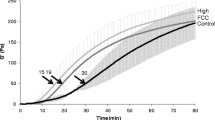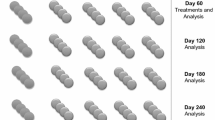Abstract
High-pressure (HP) treatment of curd at low temperatures, on top of efficiently reducing microbial loads while maintaining most of the enzymatic activity, can be useful to overcome the seasonal shortage in ovine milk production. In this work, raw ovine milk curds were subjected to a wide range of HP treatments and, after frozen storage, used in the manufacture of Hispánico cheese. Confocal scanning laser microscopy of HP-treated curds showed increasing denser and more compact protein networks with the pressure applied. Although no differences in overall porosity were recorded between HP-treated and non-pressurised curds, HP treatment lowered pore number and modified pore size and shape. Whereas confocal scanning laser microscopy of control cheese showed open structures with numerous and irregular cavities, additional highly compact protein network areas could be observed in experimental cheeses micrographs. These differences trailed off with time and were no longer observed after 60 days of ripening. Experimental cheeses had significantly lower dry matter values than control cheese, and higher proteolytic indexes. Their texture was less firm than that of control cheese throughout the whole ripening period, requiring less force to be broken and deformed. Experimental cheeses showed lower lightness values than control cheese after 30 days of ripening, but no differences were found after 60 days. Our results indicate that frozen storage of HP-treated curds from ovine milk is a viable option for the production of Hispánico cheese.







Similar content being viewed by others
References
Abramoff, M. D., Magalhaes, P. J., & Ram, S. J. (2004). Image processing with ImageJ. Biophotonics International, 11, 36–42.
Alichanidis, E., Polychroniadou, A., Tzanetakis, N., & Vafopoulou, A. (1981). Teleme cheese from deep-frozen curd. Journal of Dairy Science, 64, 732–739.
Alonso, L., Juárez, M., Ramos, M., & Martín-Álvarez, P. J. (1987). Effects of changes during ripening and frozen storage on the physicochemical and sensory characteristics of Cabrales cheese. International Journal of Food Science and Technology, 22, 525–534.
Alonso, R., Picon, A., Rodríguez, B., Gaya, P., Fernández-García, E., & Nuñez, M. (2011). Microbiological, chemical and sensory characteristics of Hispánico cheese manufactured using frozen high pressure treated curds made from raw ovine milk. International Dairy Journal, 21, 484–492.
Association of Official Analytical Chemists. (1984). Official Methods of analysis (14th ed). Washington, D.C., USA.
Auty, M., Twomey, M., Guinee, T. P., & Mulvihill, D. M. (2001). Development and application of confocal scanning laser microscopy methods for studying the distribution of fat and protein in selected dairy products. The Journal of Dairy Research, 68, 417–427.
Ávila, M., Garde, S., Gaya, P., Medina, M., & Nuñez, M. (2006). Effect of high-pressure treatment and a bacteriocin-producing lactic culture on the proteolysis, texture, and taste of Hispánico cheese. Journal of Dairy Science, 89, 2882–2893.
Ávila, M., Garde, S., & Nuñez, M. (2008). Effect of a bacteriocin-producing lactic culture and high-pressure treatment on the colour of Hispánico cheese. Milchwissenschaft, 63, 406–409.
Buffa, M. N., Trujillo, A. J., Pavia, M., & Guamis, B. (2001). Changes in textural, microstructural, and colour characteristics during the ripening of cheeses made from raw, pasteurized or high-pressure-treated goats’ milk. International Dairy Journal, 11, 927–934.
Buffa, M. N., Guamis, B., Saldo, J., & Trujillo, A. J. (2003). Changes in water binding during ripening of cheeses made with raw, pasteurized or high-pressure-treated goat milk. Le Lait, 83, 89–93.
Capella, M., Mor-Mur, M., Sendra, E., & Guamis, B. (2001). Effect of high-pressure processing on physico-chemical characteristics of fresh goats’ milk cheese (Mató). International Dairy Journal, 11, 165–173.
Casla, D., Fontecha, J., Gomez, R., & Pelaez, C. (1995). The effects of freezing and frozen storage of ewes milk cheese on the viability and proteolytic activity of lactococci used as a starter. Zeitschrift für Lebensmittel-Untersuchung und -Forschung, 200, 59–63.
Church, F. C., Swaisgood, H. E., Porter, D. H., & Catignani, G. L. (1983). Spectrophotometric assay using o-pthaldialdehyde for determination of proteolysis in milk and isolated milk proteins. Journal of Dairy Science, 66, 1219–1227.
Fallico, V., Tuminello, L., Pediliggieri, C., Horne, J., Carpino, S., & Licitra, G. (2006). Proteolysis and microstructure of Piacentinu Ennese cheese made using different farm technologies. Journal of Dairy Science, 89, 37–48.
Fontecha, J., Peláez, C., Juárez, M., & Martín-Hernández, M. C. (1994). Effect of freezing and frozen storage on the physicochemical, organoleptic and microbiological characteristics of a semi-hard ewes’ milk cheese. The Journal of Dairy Research, 61, 133–142.
Ha, J. K., & Lindsay, R. C. (1991). Contribution of cow sheep and goats milk to characterizing branched-chain fatty acid and phenolic flavors in varietal cheeses. Journal of Dairy Science, 74, 3267–3274.
Hussain, I., Bell, A. E. & Grandison A. S. (2012). Mozzarella-type curd made from Buffalo, cows’ and ultrafiltered cows’ milk. 1. Rheology and microstructure. Food and Bioprocess Technology. doi:10.1007/s11947-012-0834-5
IDF. (2002). IDF Standard 162:2002 (BS ISO 11814: 2002): dried milk—assessment of heat treatment intensity. Brussels: International Dairy Federation.
Johnston, D. E., & Darcy, P. C. (2000). The effects of high pressure treatment on immature Mozzarella cheese. Milchwissenschaft, 55, 617–620.
Kalab, M. (1984). Artifacts in conventional scanning electron-microscopy of some milk-products. Food Microstructure, 3, 95–111.
Messens, W., Dewettinck, K., van Camp, J., & Huyghebaert, A. (1998). High pressure brining of Gouda cheese and its effect on the cheese serum. Lebensmittel-Wissenschaft und Technologie, 31, 552–558.
Messens, W., Estepar-García, J., Dewettinck, K., & Huyghebaert, A. (1999). Proteolysis of high-pressure-treated Gouda cheese. International Dairy Journal, 9, 775–782.
Messens, W., van de Walle, D., Arevalo, J., Dewettinck, K., & Huyghebaert, A. (2000). Rheological properties of high-pressure treated Gouda cheese. International Dairy Journal, 10, 359–367.
MMAMRM (Ministerio de Medio Ambiente y Medio Rural y Marino). (2010). Anuario de Estadística 2010. www.mapa.es/estadistica/pags/anuario/2010.
Molina, E., Ramos, M., Alonso, L., & López-Fandiño, R. (1999). Contribution of low molecular weight water soluble compounds to the taste of cheeses made of cows’, ewes’ and goats’ milk. International Dairy Journal, 9, 613–621.
Muir, D. D. (1984). Reviews of the progress of dairy science—frozen concentrated milk. The Journal of Dairy Research, 51, 649–664.
Mujica-Paz, H., Valdez-Fragos, A., Tonello Samson, C., Welti-Chanes, J., & Torres, J. A. (2011). High-pressure processing technologies for the pasteurization and sterilization of foods. Food and Bioprocess Technology, 4, 969–985.
Needs, E. C., Stenning, R. A., Gill, A. L., Ferragut, V., & Rich, G. T. (2000). High-pressure treatment of milk: effects on casein micelle structure and on enzymic coagulation. The Journal of Dairy Research, 67, 31–42.
Norton, T., & Sun, D.-W. (2008). Recent advances in the use of high pressure as an effective processing technique in the food industry. Food and Bioprocess Technology, 1, 2–34.
Nuñez, M., Guillén, A. M., Rodríguez-Marín, M. A., Marcilla, A. M., Gaya, P., & Medina, M. (1991). Accelerated ripening of ewes’ milk Manchego cheese: the effect of neutral proteinases. Journal of Dairy Science, 74, 4108–4118.
Picon, A., Alonso, R., Gaya, P., Fernández-García, E., Rodríguez, B., de Paz, M., et al. (2010). Microbiological, chemical, textural and sensory characteristics of Hispánico cheese manufactured using frozen ovine milk curds scalded at different temperatures. International Dairy Journal, 20, 344–351.
Picon, A., Alonso, R., Gaya, P. & Nuñez, M. (2012). High-pressure treatment and freezing of raw goat milk curd for cheese manufacture: effects on cheese characteristics. Food and Bioprocess Technology. doi:10.1007/s11947-012-0923-5.
Read, N. D., & Jeffree, C. E. (1988). Common artifacts associated with biological-material examined by low-temperature scanning electron-microscopy. Institute of Physics Conference Series, 93, 17–18.
Rovira, S., López, M. B., Ferrandini, E., & Laencina, J. (2011). Hot topic: microstructure quantification by scanning electron microscopy and image analysis of goat cheese curd. Journal of Dairy Science, 94, 1091–1097.
Saldo, J., McSweeney, P. L. H., Sendra, E., Kelly, A. L., & Guamis, B. (2002). Proteolysis in caprine milk cheese treated by high pressure to accelerate cheese ripening. International Dairy Journal, 12, 35–44.
Sendra, E., Mor-Mur, M., Pla, R., & Guamis, B. (1999). Evaluation of freezing pressed curd for delayed ripening of semi-hard ovine cheese. Milchwissenschaft, 54, 550–553.
Sendra, E., Saldo, J., Mor-Mur, M., Pla, R., & Guamis, B. (2002). Long term frozen storage of Manchego curds. Milchwissenschaft, 57, 635–637.
Sheehan, J., Huppertz, T., Hayes, M. G., Kelly, A. L., Bersford, T. P., & Guinee, T. P. (2005). High pressure treatment of reduced-fat Mozzarella cheese: effects on functional and rheological properties. Innovative Food Science and Emerging Technologies, 6, 73–81.
Syverud, K., Chinga, G., Johnssen, P.O., Leirset, I., & Wiik, K. (2007). Analysis of lint particles from full-scale printing trials. Appita Journal, 60, 286–290.
Tejada, L., Gómez, R., Vioque, M., Sánchez, E., Mata, C., & Fernández-Salguero, J. (2000). Effect of freezing and frozen storage on the sensorial characteristics of Los Pedroches, a Spanish ewe cheese. Journal of Sensory Studies, 15, 251–262.
Tejada, L., Sánchez, E., Gómez, R., Vioque, M., & Fernández-Salguero, J. (2002). Effect of freezing and frozen storage on chemical and microbiological characteristics in sheep milk cheese. Journal of Food Science, 67, 126–129.
Trujillo, A. J., Capellas, M., Buffa, M., Royo, C., Gervilla, R., Felipe, X., et al. (2000a). Application of high pressure treatments for cheese production. Food Research International, 33, 311–316.
Trujillo, A. J., Guamis, B., & Carretero, C. (2000b). A procedure for the manufacture of goat milk cheese with controlled microflora by means of high hydrostatic pressure. Food Chemistry, 69, 73–79.
Vincent, L., & Soille, P. (1991). Watersheds in digital spaces: An efficient algorithm based on immersion simulations. IEEE Pattern Analysis and Machine Intelligence, 13, 583–598.
Visser, J. (1991). Factors affecting the rheological and fracture properties of hard and semi-hard cheeses. International Dairy Federation Bulletin, 268, 49–60.
Vodovotz, Y., Vittadini, E., Coupland, J., McClements, D. J., & Chinachoti, P. (1996). Bridging the gap: use of confocal microscopy in food research. Food Technology, 5, 74–82.
Yokohama, H., Sawamura, N. & Motobayashi, N. (1992). Method for accelerating cheese ripening. European Patent Application EP 0469857 A1.
Acknowledgements
This work was supported by project AGL2004-06051/ALI from the Ministry of Science and Innovation (MCINN). R. Alonso thanks INIA for her Predoctoral fellowship. K.H.M. van Wely is supported by a JAE-Doc fellowship from the Spanish National Research Council (CSIC). The authors thank M. de Paz and B. Rodríguez for their valuable technical assistance in the cheese-making trials and HP treatments.
Author information
Authors and Affiliations
Corresponding author
Rights and permissions
About this article
Cite this article
Picon, A., Alonso, R., van Wely, K.H.M. et al. Microstructural, Textural and Colour Characteristics During Ripening of Hispánico Cheese Made Using High-Pressure-Treated Ovine Milk Curd. Food Bioprocess Technol 6, 3056–3067 (2013). https://doi.org/10.1007/s11947-012-0955-x
Received:
Accepted:
Published:
Issue Date:
DOI: https://doi.org/10.1007/s11947-012-0955-x




